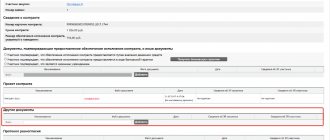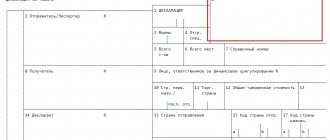Please note: the abbreviation CCD, like the very concept of “cargo customs declaration”, is outdated. Now there is a “declaration of goods” - TD, however, both of these terms are still often used.
A prerequisite for conducting foreign economic activity, in particular the transportation of goods across state borders for commercial purposes, is the declaration of goods, namely, filling out a cargo customs declaration for the goods being transported. At the same time, the obligatory procedure is the payment of customs duties and other payments, which are calculated on the basis of the declaration of customs value, which is an integral part of the cargo customs declaration; without it, the cargo TD will not have legal force.
Customs control must request a declaration of goods
The DTS is a special document that reflects the value of the goods that are transported across the state border. At its core, this document is a settlement form that reflects the costs of purchasing products, transportation costs for transporting trade and material assets through customs.
In order to correctly fill out documents and pass customs control without any problems, you need to know the procedure for preparing TTS declarations, the structure of TTS, how declaration and adjustment of customs value occurs in general if necessary. All these tasks will be undertaken by specialists: we provide the full range of customs services and will help you pass customs control quickly and without bureaucratic delays.
What is DTS
The procedure for transporting goods across state borders when conducting foreign economic activity requires documentary confirmation; the main document that is presented when going through the customs control procedure is the DTS declaration. That is, this document, which is a specialized type of reporting documentation, is issued as accompanying documentation for goods transported through customs posts and state borders.
Sample declaration of customs value DTS 1
Its actual purpose is to determine the value of the goods being transported, that is: how much the goods cost, how much was paid to the carrier for its delivery to the customs point. The information entered into the DTS is used to calculate duties, fees and other payments. For example, goods must be placed in a temporary storage warehouse (temporary storage warehouse), in this case, documentary evidence of their value will be required, and the TTS will be such a document and value confirmation.
It indicates not only the cost itself, but also the way in which it was calculated. The declared value must be confirmed by documents for the goods so that customs officers can check the dumped value for accuracy; if unreliable calculations are detected, customs may make a decision to refuse to accept the vehicle declaration. In addition, if not supported by documents, it has no legal force.
How is the customs value of goods calculated?
Customs value is the value of the cargo, which is calculated based on international treaties of the states that are members of the Customs Union. Its calculation is carried out by the declarant or a customs broker, who can be played by specialists. The documents attached to the DTS must reflect all the information on the basis of which the calculations were made; control over the customs value is carried out by customs officers.
The calculation is carried out in several ways:
- based on the prices of transactions with goods that are transported to the countries of the Customs Union or exported from the territories of the Customs Union;
- based on prices for similar products;
- based on the cost of homogeneous cargo;
- by subtracting or adding value;
- in a backup way.
The first method is the most common, the others are used only in cases where it is not suitable, this can happen when all the required documents are missing, the buyer does not have all the rights to the cargo, or due to the lack of a fixed cost of the cargo, as a result of which it is necessary to calculate it accurately it is impossible to determine the vehicle.
The customs value of the cargo itself consists of:
- the actual price of goods indicated by the manufacturer;
- transportation costs to the border;
- loading and unloading operations;
- packaging, packaging and cost of containers;
- insurance;
- royalties and other likely payments;
- other costs that were incurred before the cargo arrived at the state border.
To properly pass customs control and successfully declare goods, you must know and comply with all current rules of Russian legislation and the Customs Code of the Customs Union. If errors were made during the transportation of goods or the preparation of documents for them, you may face penalties, and sometimes even confiscation of the goods. To avoid all these problems and difficulties, it is best to use the customs services of an experienced and reliable representative.
Methods for determining DTS
There are six methods for determining customs value.
The first is the valuation method based on the transaction price of imported goods. It is used most often (for approximately 90-98% of all imported and exported goods). The calculation formula is as follows:
Customs value = transaction price + additional deductions Additional deductions consist of:
- expenses not included in the buyer's price (remuneration to the intermediary, with the exception of payment to his intermediary; for packaging if it is considered as a single whole with the goods, etc.);
- distributed cost of goods and services that the buyer received at a reduced price or free of charge (raw materials, components; engineering, development, design, etc.);
- prices for the use of intellectual property, etc.
The second is the valuation method based on the transaction price of identical goods. The TC consists of the value of the transaction with goods identical to the imported ones (that is, products that are similar in all respects, including quality, reputation, physical characteristics), which were transported to the Russian Federation no earlier than 90 days before the import of the goods being valued.
Reference. When determining several transaction prices using this method, the smallest one is selected.
The third is the valuation method based on the transaction price of homogeneous goods, that is, products that cannot be called identical, but they have common components that allow them to perform the same functions as the goods being valued. This method uses the same principle as the previous one: if several transaction prices are detected, the lowest one is selected. The fourth is the cost subtraction valuation method. The sales price in the Russian Federation for homogeneous or identical products is reduced due to:
- commissions;
- normal profit allowances and general selling expenses;
- expenses for insurance and transport incurred within the territory of Russia;
- amounts of import customs duties.
Fifth is the valuation method based on the addition of costs. The TC consists of the total costs associated with the sale of goods in the Russian Federation from the exporting country; exporter's profit from delivery; average production costs of the exporter. The sixth is a backup method. Here, the vehicle price is calculated on the basis of global customs practice using price information provided by the customs authority.
Note. The DTS serves as the basis for calculating customs duties and fees.
It should be noted that for calculation methods, the package of accompanying documentation may vary. For example, DTS-2 is filled out in all cases, except those when the calculation method is used based on the transaction price of transported products (for this only DTS-1 is filled out).
Vehicle declaration forms and its completion
As mentioned earlier, the DTS is an obligatory part of the cargo customs declaration; it reflects the price of the transported cargo, determines the customs value, methods for its determination, conditions and circumstances of the transaction, and on its basis - all fees, duties and payments. There are certain forms of DTS for imported and exported goods. The information indicated in them is essentially the same; the declared goods must be included and the method by which their value was determined is indicated.
The document is filled out by the person presenting the cargo at customs
One copy of the DTS remains with the customs representative, the second - with the one who deals with customs clearance, it is submitted along with the cargo declaration for the goods. In addition to the paper version, an electronic version of the declaration is also created and sent to customs.
Forms DTS-1 and DTS-2
When importing goods, products and other inventory items into the territory of the EAEU, key forms are drawn up: declaration of customs value (forms DTS-1 and DTS-2). The forms and rules for their preparation are enshrined in the Decision of the Board of the Eurasian Economic Commission dated October 16, 2018 No. 160.
Forms are filled out for almost all types of goods imported into the EAEU. But there are exceptions. When declaring the customs value, the DTS is not filled out for the following categories of goods:
- if inventory items are placed under customs procedures that do not provide for the accrual and payment of duties, taxes and fees;
- if the declared values of cost indicators do not provide for the obligation to calculate and pay customs duties, taxes and duties;
- if the cost of the imported consignment does not exceed the permissible amount established by the EAEU member state (maximum 10,000 US dollars), with the exception of multiple deliveries under one contract and repeated deliveries between regular suppliers and buyers under different contracts.
Declarations are filled out in two copies. The first copy of the reporting documentation is submitted to the customs authority along with the cargo declaration. The second copy, already with a customs mark on receipt, remains with the applicant.
Filling out the declaration of customs value of the DTS
The document is filled out by the person representing the cargo at customs - the owner of the cargo, the carrier, the declarant, who may be a customs broker - an experienced specialist who knows all the intricacies of the customs control procedure.
If the goods are imported, then the DTS-1 and DTS-2 forms are filled out, if they are exported, the DTS-3 and DTS-4 forms are filled out, both of which consist of two main sheets:
- on the first one, enter data on goods that require declaration and are indicated in one customs declaration;
- on the second - methods for calculating customs value.
The following documents must be attached to the declaration, without which it will not be valid:
- settlement papers and payments;
- contracts of purchase or sale, as well as all available additions to them;
- constituent documentation.
Also, in addition to these documents, depending on the characteristics of the cargo and the declared customs procedure, customs representatives may request additional documents, including:
- Delivery contract;
- invoices that confirm payment of commission payments and other fees;
- licenses and certificates for goods;
- price lists from the manufacturer of the transported goods;
- documents from the accounting department;
- calculation of the cargo manufacturer on the cost of production.
As well as other documents confirming the declared customs value of the cargo and its calculations. This is necessary to ensure that the customs representative is convinced that all calculations were made correctly, no facts were hidden, and the cost was declared based on factual and reliable information. The electronic copy of the TDS must contain all the information specified in the addenda.
The structure and rules for filling out the customs value declaration and, in particular, its main and additional sheets are established by law; the basic information and all columns are filled in by the declarant. The basic requirements for registration are to fill out the form on the appropriate form without errors, enter all information in Russian, and be sure to enter only the information specified in the DTS form.
Declaration forms DTS-3 and DTS-4
Special forms DTS-3 and DTS-4 are issued for goods exported from the territory of the Russian Federation. The forms and procedure for filling out were approved by Order of the Federal Customs Service of the Russian Federation dated January 27, 2011 No. 152.
The forms are an integral part of the customs declaration for goods exported from the Russian Federation. But if the exported products are not subject to customs duties, taxes and duties, then it is not necessary to draw up DTS-3 and DTS-4.
Declaration reporting is generated in two copies and submitted together with the main declaration to the customs authority. One copy remains with the receiving controllers. And the second form with a mark is returned to the filler.
Adjustment of customs value
There are situations when an adjustment of the customs value is required, the customs office did not accept the DTS and did not begin to formalize the cargo. The adjustment procedure may consist of calculating all customs payments in accordance with all claims and demands made by customs officers, as well as paying duties or other necessary payments. That is, the cost of the cargo is recalculated, taking into account the adjustment of points that raised doubts among customs control, as well as the recalculation of duties, taxes and adjustment of the vehicle based on updated data.
To successfully declare goods, it is advisable to turn to professionals
Declaration and adjustment of customs value is carried out by the declarant, but adjustments can also be made by a customs officer, in this case the declarant does not need to present any additional documents. If the adjustment is carried out at the request and initiative of the customs broker, in this case we are provided with the DTS and other proposed documents.
Submission of DTS
The rules for filing TPA for import and export are the same. In both cases, the declarant fills out and submits two copies to customs officers. The first form remains with the receiving controllers, and the customs officers put the appropriate mark on the second and return it to the sender.
In what cases does it not need to be submitted?
When importing, this document is not submitted in the following cases:
- if goods are placed under customs procedures that do not provide for the payment of duties and taxes;
- if, based on the declared value, there is no obligation to pay customs duties and taxes;
- if the total customs value of the imported consignment of goods does not exceed the amount that can be established in the EAEU member state and should not exceed an amount equivalent to 10,000 US dollars, with the exception of multiple (two or more times) deliveries within the framework of one contract, as well as repeated (two or more times) deliveries of the same goods by one sender to the same recipient under different contracts.
When exporting, DTS does not need to be submitted if export customs duties and taxes are not established for the products, calculated on the basis of their customs value.
Small firms, large companies, and individual entrepreneurs conducting foreign economic activity can reduce both the financial and time costs of completing customs procedures and be confident in the successful passage of customs control by entrusting the declaration of goods to an experienced customs representative.
Our specialists have a thorough knowledge of all the provisions of the customs code and legislation of the Russian Federation, will competently draw up and fill out all the necessary documents, including declarations of customs value and cargo declaration, and will provide comprehensive support for exported and imported goods or cargo.
When to turn on DTC
- When you are confident in the grip properties of rubber and want to gain more complete control over the car (for example, on a race track).
- If you decide to “drift,” let the car go into a controlled drift.
- When you drive through snow or mud at low speed and want to increase the grip of the rubber on the surface.
- When starting from a standstill, “rocking”.
Please note that activation of the DTC does not automatically disable DSC. When traction control is activated, the DSC system will continue to function and will intervene in the vehicle when required.







